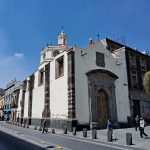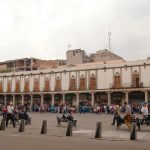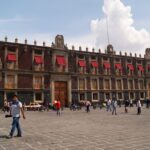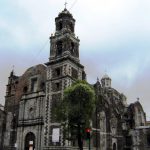

La Capilla del Señor de la Expiración es una pequeña capilla poco visitada situada en el borde de la Plaza de Santo Domingo. El edificio data probablemente de 1590, aunque fue reformado en numerosas ocasiones a lo largo de los siglos.
La capilla era una de las cuatro que marcaban las esquinas del antiguo atrio. Las “Capillas de Posa”, literalmente capillas de pausa, se utilizaban como puntos de reflexión o paradas durante las procesiones, y se cree que algunas se utilizaban para sesiones de estudio. Su función histórica exacta no está bien documentada, pero eran únicas en la arquitectura de Nueva España. Eso indica probablemente su uso en la evangelización del gran número de habitantes del lugar.
Por desgracia, las otras tres capillas ya habían desaparecido en el siglo XVII. En la segunda mitad del siglo XVIII se reconstruyó con la planta y el estilo actuales. Cuando en 1861 se retiró el antiguo muro que rodeaba el atrio, quedó esta pequeña capilla.
Como gran parte de los alrededores de Santo Domingo, no es más que una parte del complejo histórico que hoy está fragmentado en unos pocos lugares históricos que quedan.
La parte norte de la plaza, la que está inmediatamente delante de la Capilla del Señor de la Expiración, fue rebautizada en honor del movimiento estudiantil de 1929. Aquella serie de acciones condujo a la autonomía de la Universidad Nacional, y se conmemora el 23 de mayo (Día del Estudiante en México). Por ello, la plaza pasó a llamarse Plaza de 23 de mayo.
 Cuando se diseñó el convento de los dominicos en la capital del virreinato se destinó una esquina del predio para templo y atrio. El templo sobrevive en el sitio hasta hoy, pero la barda que delimitaba el atrio cayó en el siglo XIX. En el atrio hubo varias capillas para alojar a los vecinos y devotos organizados en hermandades o cofradías. Para el siglo XVII los dominicos propiciaron la creación de una hermandad de negros y mulatos advocada a Cristo en su expiración y la Virgen de la Consolación, la capilla fue reconstruida en el siglo XVIII y tuvo cuatro altares con retablos.
Hoy es la única capilla que sobrevive en el espacio que ocupó el atrio de Santo Domingo, y fue testigo de la represión que orquestaron policías y bomberos contra estudiantes de la Universidad el 23 de mayo de 1929, y que derivó en la Autonomía de la Universidad Nacional.
Cuando se diseñó el convento de los dominicos en la capital del virreinato se destinó una esquina del predio para templo y atrio. El templo sobrevive en el sitio hasta hoy, pero la barda que delimitaba el atrio cayó en el siglo XIX. En el atrio hubo varias capillas para alojar a los vecinos y devotos organizados en hermandades o cofradías. Para el siglo XVII los dominicos propiciaron la creación de una hermandad de negros y mulatos advocada a Cristo en su expiración y la Virgen de la Consolación, la capilla fue reconstruida en el siglo XVIII y tuvo cuatro altares con retablos.
Hoy es la única capilla que sobrevive en el espacio que ocupó el atrio de Santo Domingo, y fue testigo de la represión que orquestaron policías y bomberos contra estudiantes de la Universidad el 23 de mayo de 1929, y que derivó en la Autonomía de la Universidad Nacional.
Ruta del Corazón de México: Ruta Santo Domingo - Santa Catarina
< <Portal de los Evangelistas | Palacio de la Inquisición > >
Proyecto “Corredor de Cultura Digital”.
Nombre de la investigación: Investigación Centro Histórico, Monumentos, Edificios y Puntos de Interés (2023)
Dirección de investigación y diseño de Rutas: Acércate al Centro A.C. Guadalupe Gómez Collada
Coordinación e investigación histórica: Fideicomiso del Centro histórico Dir. Maestra Loredana Montes

Cercano a 0.06 kms.

Cercano a 0.06 kms.

Cercano a 0.08 kms.

One of Central Mexico City's most important historic plazas . . .

Una visión fascinante y muy real del siglo XVII en la Ciudad de México.

El antiguo edificio de la aduana hoy muestra parte de la extensa colección de arte de la SEP.

Uno de los templos barrocos antiguos más espectaculares de la Ciudad es la iglesia parroquial de La Lagunilla.

Still one of the most magnificent of center city palaces, that of the Inquisition is not one to miss.